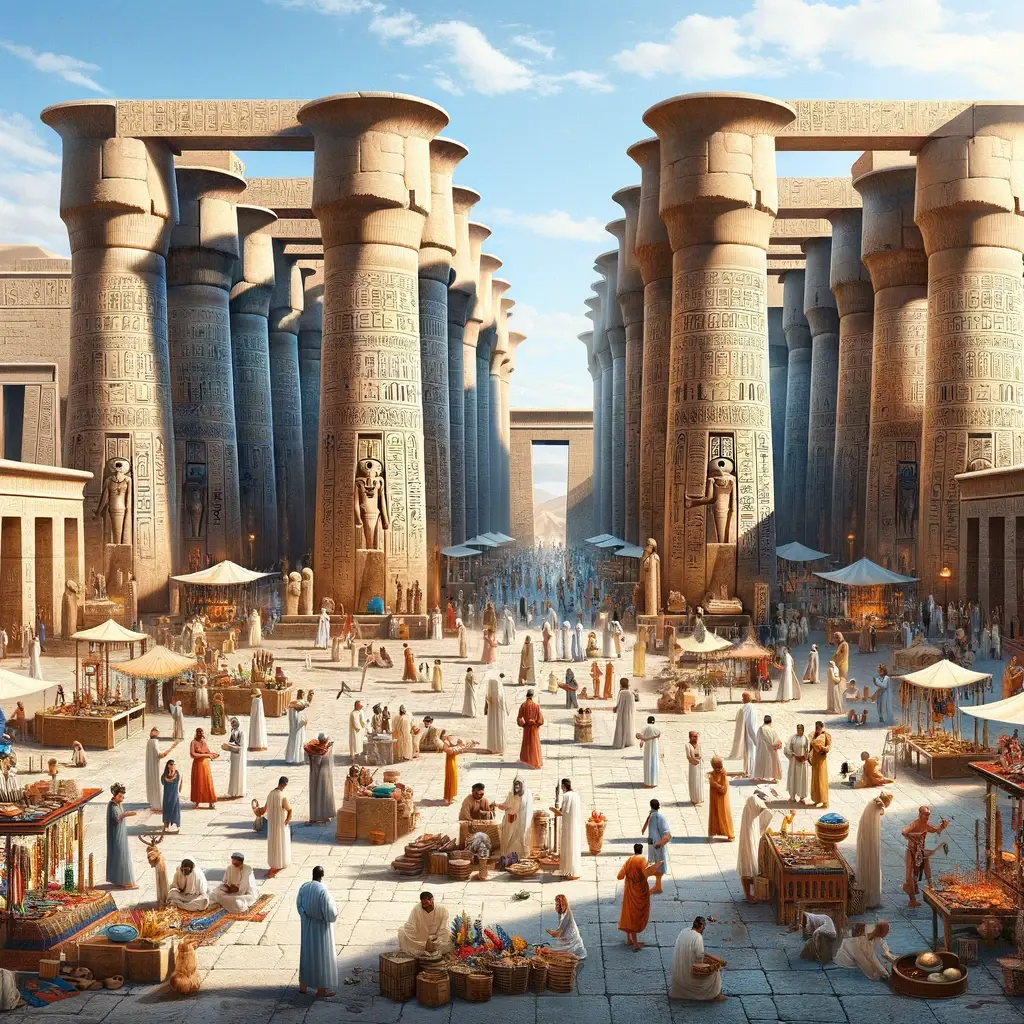
Imagine standing before an ancient Egyptian temple—not just a monument of stone and hieroglyphs, but a living, breathing center of a civilization that has fascinated the world for millennia. These temples were the backdrop of life in Ancient Egypt, from sacred ceremonies to bustling marketplaces. They were places of worship, knowledge, and community, serving a purpose that extended far beyond their spiritual significance. Today, we’re peeling back the layers of history to uncover the dynamic and multifunctional role of temples in ancient Egyptian society. Let’s step into the past and discover how these timeless structures shaped the very fabric of everyday life along the Nile.
Religious Significance of Ancient Egyptian Temples
House of the Gods
In ancient Egypt, each temple, also known as the ‘House of the Gods’, served immense religious significance. Embedded deeply in the fabric of ancient Egyptian society, these edifices stood as sacred sites where mortals interacted with the divine. They were houses for the gods, providing them with sanctuaries on earth. Each temple was dedicated to a specific deity and was considered its physical dwelling. Priests performed daily rituals to care for these resident gods, which included clothing, feeding, and presenting offerings.
Believed to sustain the gods, these rituals were crucial in maintaining the cosmic order. These temples also often functioned as tangible representations of the cosmic world, echoing the beliefs of life, death, and the afterlife in their architecture. They hosted religious festivals, processions, and ceremonial rites, thereby serving as critical centers for public participation in religious life.
Centers for Rituals and Worship
Centers for Rituals and Worship, as related to the Religious Significance of Ancient Egyptian Temples, refers to the grand and elaborate structures built by the ancient Egyptians as the place of worship and enactment of various religious rites and ceremonies. Essential to Egyptian religion, these temples were considered the literal homes of gods and goddesses, embodying their presence in the physical world.
Within these sacred precincts, priests performed complex rituals including daily offerings and prayers on behalf of the Pharaoh – regarded as the intermediary between gods and humans – as well as larger festivals and events, which were based on Egypt’s agricultural and celestial calendars. Each temple was dedicated to a specific deity and was adorned with intricate decorations and inscriptions telling mythological stories, emphasizing its spiritual significance. Priests carefully guarded these sacred spaces and only permitted entrance to the high-borne and the royal.
Temples as Political Centers
Symbol of Pharaoh’s Authority and Power
In Ancient Egypt, temples served as political centers and were core symbols of the Pharaoh’s authority and power. They represented significant elements in the socio-political culture, affirming the Pharaoh’s divine status, and reinforcing his hold over the land. Usually grandiose in scope, they showcased intricate architecture and adorned with elaborate carvings, specifically to propagate the might and divinity of the Pharaoh.
The structure served multiple roles; palace, court, treasury, and religious center. Through rites and ceremonies, the Pharaoh as the divine monarch connected with the gods, soliciting favor and assurance for his people’s prosperity. Thus, the temples as political centers were not only the administrative hub but evident reminders of the Pharaoh’s omnipresent command. Even though the priests managed the regular functions, the ultimate control resided with the Pharaoh.
A Place for Diplomatic Activities
Temples, in many ancient civilizations, not only served as places of worship but also as pivotal political centers where diplomatic activities took place. These sacred structures were often situated at the heart of cities, epitomizing their societal prominence. Here, priests and rulers, the primary political figures of the time, would convene within these hallowed halls discussing state matters, forming alliances, and even negotiating with other political entities.
The authoritative aura that these temples possessed amplified the gravity of the political conversations and decisions made within their confines. Temple diplomacy was a significant part of the political landscape, adding a layer of religious legitimacy to political decisions, and serving as a medium for interaction and negotiation between different polities. More than just a religious sanctuary, temples were diplomatic venues asserting the power dynamics and political structure of ancient societies, acknowledging both divine and diplomatic procedures.
Temples as Economic Hubs
Centers for Trade and Agriculture
In ancient societies, temples often served as significant economic hubs, with a profound relationship to centers for trade and agriculture. Temples were not only places of worship but were also pivotal players in the economic activities of the society. They served as storage centers for agricultural produce and sometimes as venues for trade and barter exchanges.
Farmers would donate a portion of their crops to the temples as a form of tax or religious offering. These offerings were then used or traded within the local economy, thereby linking agriculture directly with the economic influence of the temple. Moreover, temples acted as marketplaces where traders from different regions would come to buy, sell or barter goods. This arrangement ensured the circulation of commodities, promoting both local and long-distance trade networks. Therefore, the relationship between centers for trade and agriculture and temples highlights the multifaceted role of these religious structures in ancient economies.
Source of Employment
Temples often play significant roles as economic hubs, thereby serving as a source of employment for many individuals in their localities. A myriad of job roles are associated with temples, which require skilled and unskilled workers to take up responsibilities. For instance, there are essential positions to uphold the religious aspects, such as priests, spiritual advisors, and other religious personnel. Besides, employees are needed for administrative roles like management, accounting, housekeeping, and site maintenance.
Moreover, many temples also bolster local economies indirectly through associated industries. With the inflow of pilgrims, several ancillary services like hospitality, tourism, food and beverage services, and local handicrafts businesses thrive. These services can generate a significant number of employment opportunities for locals as well as migrants. Furthermore, temples can also provide employment in educational services, as many host religious or spiritual classes, conferences and seminars.
Architectural Significance of Temples
Reflecting Ancient Egyptian Cosmology
The architectural significance of temples in ancient Egypt is deeply intertwined with their cosmological beliefs. Ancient Egyptians perceived their temples as sacred cosmological maps that mirrored their understanding of the universe. Not just sites for religious rites, these edifices served as a physical representation of the Egyptian cosmos. They were meticulously designed and built to reflect significant celestial events and patterns they believed influenced their daily lives.
The alignment, design elements, and even decorations often bore esoteric meanings connected to celestial bodies and events. For example, the axis lines of the majority of Egyptian temples were oriented toward the points of the sun’s rise or set at summer and winter solstices. The inner sanctum typically represented the underworld, the court symbolized the land of living, and the obelisks and sun court associated with the celestial realm. Temples were therefore more than architectural masterpieces; they were expressions of ancient Egyptian cosmology.
Innovations and Architectural Brilliance
Temples, since ancient times, have represented not only places of worship but also the pinnacle of architectural brilliance and adaptability. These sacred structures are exemplars of mankind’s ability to innovate and amalgamate functionality with aesthetic appeal. Architects and craftsmen have employed innovation, drawing on multiple disciplines such as geometry, artistry, engineering, astronomy, and more to erect structures that can withstand various environmental challenges.
Temples like the Angkor Wat in Cambodia, Parthenon in Athens or the Chola temples of Southern India showcase a wide array of architectural styles, concepts, and construction techniques. These structures are renowned for their intricate carvings, meticulous relief work, and towering Gopurams (gateway towers), demonstrating the innovative use of stone, brick, mortar, and wood. The precision in a temple’s location, orientation, and construction also carries significant celestial and terrestrial symbolism.
Temples and Egyptian Society
Role in Festival Celebrations
Temples held a pivotal role in festival celebrations within the context of ancient Egyptian society, embodying both religious and social significance. Egyptian festivals were primarily religious events, acknowledging and celebrating the gods and their deeds. Temples served as the stage for these celebrations as the centre of religious practices. Priests would open the shrine of the deity housed within the temple and carry the deity’s representation in a grand procession, followed by festival participants carrying offerings. This sacred march would typically extend beyond the temple precincts and into the surrounding community.
The temple’s resources were used to feed participants in massive banquets, reinforcing its role as a central institution in the economic life of the community. Additionally, festivals facilitated social unity among Egyptians, as people from all walks of life joined together in communal rites and revelry, centred around the temple. Therefore, the temple’s role in festival celebrations was multifaceted.
Temples as Educational Centers
Temples played a crucial role within Egyptian society, not only as places of worship but also as educational centers. The temple complex was essentially an intellectual hub where various activities took place, such as training in religious rites, the compilation of chronological events, and the study of mathematics, science, medicine, and other scholarly fields. High-ranking priests and priestesses were highly literate and educated, often acting as teachers.
They instructed their disciples not just in religious wisdom but also in various theoretical and practical fields, preparing them for different administrative and functional roles within society. Furthermore, these complexes housed libraries that held papyrus scrolls and written records, making them akin to modern libraries and repositories of knowledge. The wise men from this era, therefore, were benefactors of such an educational system pioneered by the temple education centers. The temple’s critical function as an educational hub significantly contributed to the cultural, religious, and intellectual enrichment of the society, serving as a focal point for scholarly activity and the dissemination of knowledge.
Conclusion
Reflecting on the grandeur and intricacies of ancient Egyptian temples, we find our answer: They were the linchpins of Egyptian culture. These temples were not just religious sanctuaries; they were vital to the cohesion and function of society. They served as centers for worship, offering a direct link to the divine. Temples were also hubs of education, where scribes and scholars nurtured the wisdom of the ages.
Economically, they acted as treasuries and distribution centers, stabilizing and enriching the kingdom. Politically, they were stages for pharaohs to display power and for people to gather. In conclusion, the temples of ancient Egypt were multi-dimensional, interwoven into the fabric of daily life, embodying society’s heart and soul, and ensuring the civilization’s enduring legacy.

